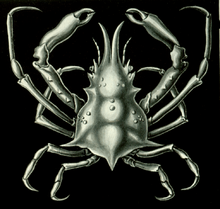Pisa armata
Pisa armata is a species of crab from the eastern Atlantic Ocean.
| Pisa armata | |
|---|---|
 | |
| Scientific classification | |
| Kingdom: | |
| Phylum: | |
| Subphylum: | |
| Class: | |
| Order: | |
| Infraorder: | |
| Family: | |
| Genus: | |
| Species: | P. armata |
| Binomial name | |
| Pisa armata (Latreille, 1803) | |
| Synonyms[1] | |
| |
Description
Pisa armata grows to a length of 40 millimetres (1.6 in).[2] Its carapace is roughly triangular, with two prominent rostral spines, which are parallel in males, but divergent in females.[2] The carapace is brown, but is often covered in seaweed, sponges or anemones.[2]
Distribution
Pisa armata is found in the eastern Atlantic Ocean from around the Isle of Man as far south as Angola, as well as in parts of the Mediterranean Sea.[3] It lives at depths of 1–108 metres (3 ft 3 in–354 ft 4 in).[3]
Ecology
Pisa armata is parasitised by a rhizocephalan barnacle. Although initially considered to be the same species that attacks other crabs such as Carcinus maenas, experiments in the 1960s demonstrated that the two were different species, Sacculina carcini on C. maenas, and Sacculina gibbsi on P. armata.[4]
References
- Charles Fransen & Michael Türkay (2011). "Pisa armata (Latreille, 1803)". WoRMS. World Register of Marine Species. Retrieved January 15, 2012.
- Andrew Campbell (2005). "Pisa armata (Latreille)". Philip's Guide to Seashores and Shallow Seas of Britain and Northern Europe. Philip's. p. 235. ISBN 978-0-540-08747-1.
- R. W. Ingle & P. F. Clark (1980). "The larval and post-larval development of Gibbs's spider crab, Pisa armata (Latreille) [family Majidae: subfamily Pisinae], reared in the laboratory". Journal of Natural History. 14 (5): 723–735. doi:10.1080/00222938000770601.
- H. Boschma (1972). "On the occurrence of Carcinus maenas (Linnaeus) and its parasite Sacculina carcini Thompson in Burma, with notes on the transport of crabs to new localities" (PDF). Zoologische Mededelingen. 47 (11): 145–155.
External links
- "Pisa armata". Macrobenthos of the North Sea – Crustacea.
- Bob Mehen (September 29, 2011). "Rare crustaceans find new home at Cornish aquarium". Practical Fishkeeping. Archived from the original on June 5, 2013. Retrieved January 15, 2012.